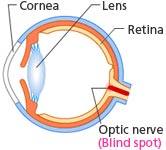Although the distance between the moon and the earth does not vary, a moon that has just risen appears overly large. Although the red warning lights at a railway crossing are simply flashing on and off in alternation, they can appear to be moving. The world that we see is not necessarily the actual world before us. Are you seeing the world as it really is?
The wonder of seeing
In the pre-Christian era, painters vied with one another to paint more realistically. Gaius Plinius Secundus (23-79AD), known as Pliny the Elder, a natural historian in Ancient Rome, relates the following anecdote in his work “Naturalis Historia.”

Water falls and the water wheel rotates. If we look at the channel to the right of the water wheel, it appears to be descending as the water flows away from the wheel. However, if we then look at the channel support struts, the water is falling from what we thought of as the channel's lowest point—the end of the channel in fact appears to be its highest point.
All M.C.Escher works ©Escher Holding B.V. - Baarn - the
Netherlands. / Huis Ten Bosch - Japan
When competing with a rival painter named Parrhasios to decide who could paint more realistically, Zeuxis, a Greek artist, painted grapes that looked so real the birds came down to eat them. Believing that he had won, Zeuxis asked his competitor to draw back the curtain covering his own painting and reveal it. However, the curtain itself was the painting. Although his picture deceived the birds, his rival's painting deceived him, and Zeuxis conceded victory to Parrhasios.
A painting that captures reality precisely, as if it were right before your eyes, is called a “trompe l'œil” (French for “deceive the eye”). There may be those who object to the use of the word “deceive;” however, it is our visual perception that is deceived by a trompe l'œil and we take pleasure in this when we realize we have been fooled. A trompe l'œil is thus a work of humor.
Active in the early part of the twentieth century, M.C. Escher (1898-1972) was probably the most well-known of artists who were fascinated by the wonder of visual perception. Escher was consumed with the depiction of regularity, continuity, and depth of space. He described the process of drawing his amazing world as he always draws, imagining he is creating the world's most beautiful thing.
The wonder of seeing is steeped in romance. There are many cases in which our visual perception is fooled and sometimes even modern science cannot explain why things appear as they do. Are we really then seeing the world in its true form?
Not everything can be seen

The point where the fibers of the optic nerve bunch together, where it is impossible to form an image of what is seen, is known as “the blind spot.”
As we consider whether or not we perceive the world as it really is, let us first take a look at the relationship between seeing and appearance.
For example, as you read through this text, the point at which you are looking will move rapidly from right to left when you finish each line. This type of rapid movement of the eyeball is known as “saccade eye movement.” In other words, we look or read something by repeatedly keeping our line of sight fixed for about 300 milliseconds and then performing a few tens of milliseconds of saccade eye movement. However, we do not take in anything we see during saccade eye movement (that is, nothing is apparent to us).
There are also things that are invisible to us. The term “blind spot” is used frequently, but few people are probably aware that we really do have a blind spot. The term refers to the point opposite the pupil where the fibers of the optic nerve bunch together. As there is no retina here to form an image, seeing is not possible. Usually we do not notice this because the brain fills in what we cannot see.
Let us try a simple experiment to get a feel for the blind spot.

With your right eye closed, look at the red rose on the right while slowly moving some 40 cm back and forth from the computer screen. As you get up close to or move away from the screen, the yellow bud on the left seems to disappear at some point.
- [Note] Please do not stare at the screen for too long or repeat the experiment over and over again.
As well as making the visible invisible (as in the case of saccade eye movement), the brain sometimes makes the invisible visible, as demonstrated by this experiment illustrating the blind spot. Therefore, the world we see is the resultant world after the brain has regulated visual information.
What is an optical illusion?
When someone perceives something in a form that differs from its rightful form, this is known as an “illusion.” Although with illusions there is also the unavoidable philosophical question of what constitutes “rightful form,” here let us simply consider “rightful form” in a practical sense.
An illusion that is related to visual perception is known as an “optical illusion.” For the past 150 years or so, scientific research into optical illusions has advanced in the psychological field. We now know that when an optical illusion occurs, different regions of the brain are involved according to aspects such as color and shape. However, many mysteries remain unsolved.
We can say that trompe l'œil pictures and optical illusion designs are the same in the sense that they are both connected with our mechanism of visual perception. In academic terms, however, trompe l'œil and optical illusions are clearly different from one another. In short, trompe l'œil does not make use of optical illusion.
The key difference is that with a trompe l'œil the inconsistency is exposed in its entirety just before the brain completes the process of seeing. In psychology this is termed “high-order perception.” In contrast, an optical illusion occurs at the point when we perceive shape or color, which is termed “low-order perception.” In other words, it occurs in the very first stage of the process of seeing.
Research into optical illusions began in the nineteenth century. In tandem with advances in brain science, research is progressing on issues such as determining which parts of the brain are involved. As research moves forward, the goal of science is to explain everything according to a single principle. Will we thus be able to explain optical illusions according to some single unified theory?
Professor Akiyoshi Kitaoka of Ritsumeikan University says that we will not. Since the occurrence of each optical illusion is based on an individual mechanism, and depends on whether shapes or colors are involved, it is not possible to explain all optical illusions using a single theory. This is precisely why the design of such illusions is so crucial to shedding light on optical illusions.
Optical illusions caused by the brain
In some optical illusions, objects appear to move in either direction, despite the fact that they are still images. Typically in the case of optical illusions that appear to move, the design makes it appear that the image's direction of rotation is from black to gray and gray to white.
This illusion consists of two sets of concentric circles, which are designed to appear to rotate. The direction of rotation is from black to gray and from white to gray. Two images are used in order to exploit the viewer's natural tendency to look from one to the other alternately, making it easier for an optical illusion to occur.
“A fractional shift in point of view is necessary in order for the optical illusion to occur,” says associate professor Hiroshi Ashida of Kyoto University. As described previously, our eyeball is constantly vibrating. This vibration is usually imperceptible. However, when we see an object, our neurons (which are continuously emitting positive and negative electrical signals) emit negative signals that are slightly stronger than the positive ones. As a result, when we see a pattern like the one in the diagram, movement in the direction from black to dark gray and from white to light gray generates a stronger movement signal than movement in the reverse direction. This causes us to sense movement slightly more strongly in one particular direction and thus the whole image appears to rotate.
Humans do not have the capability to disregard information that they see or to fill in missing information from the start. Within a few months of birth, we develop these necessary survival capabilities. The world which we see only becomes apparent to us with the combination of considerable learning and brain function. The optical illusion is a phenomenon that arises in the gap between the two, and poses afresh the question of what seeing is.
It is fascinating that the drawing of pictures and the design of optical illusions are playing a part in this research. “There is an important relationship between the observation of phenomena using design, and the development and verification of models.” says Professor Kitaoka. Considering what makes something beautiful while creating beautiful things is a basic pathway to any kind of learning.
Editorial contributors / Date of article posted
Professor Akiyoshi Kitaoka of Ritsumeikan University and Associate Professor Hiroshi Ashida of Kyoto University / October 2006

